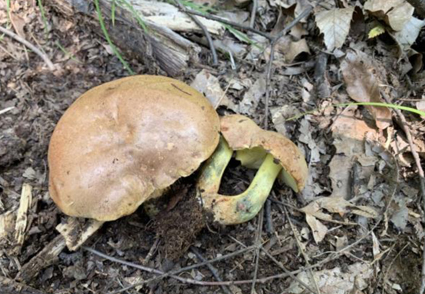Abstract
Butyriboletus brunneoides sp. nov. and Bu. sinoregius sp. nov. are described from Shanxi Province of China based on morphology and molecular work. Butyriboletus brunneoides differs from Bu. brunneus by the small to medium basidiome, smooth pileus, and a thin stipe that develops reddish stains near the base. Butyriboletus sinoregius differs from the European B. regius by a basidiome bluing when bruised and a pileus covered with fine tomentum. Phylogenetic analyses based on ITS, nrLSU, tef1-α and rpb2 sequences support the taxonomic position of the two new species. Illustrated macro- and micro-descriptions are provided along with a key to the Butyriboletus species from China.
References
Arora, D. & Frank, J.L. (2014) Clarifying the butter boletes: a new genus, Butyriboletus, is established to accommodate Boletus sect. Appendiculati, and six new species are described. Mycologia 106 (3): 464–480. https://doi.org/10.3852/13-052
Assyov, B. (2012) Revision of Boletus section appendiculati (Boletaceae) in bulgaria with a key to the balkan species. Turkish Journal of Botany 36 (4): 408–419. https://dx.doi.org/10.3906/bot-1104-10
Bessette, A., Roody, W.C. & Bessette, A.R. (2000) North American boletes: a color guide to the fleshy pored mushrooms. Syracuse University Press. New York, 396 pp.
Gardes, M. & Bruns, T.D. (1993) ITS primers with enhanced specificity for basidiomycetes–application to the identification of mycorrhizae and rusts. Molecular Ecology 2 (2): 113–118. https://doi.org/10.1111/j.1365-294X.1993.tb00005.x
Hillis, D.M. & Bull, J.J. (1993) An empirical test of bootstrapping as a method for assessing confidence in phylogenetic analysis. Systematic Biology 42 (2): 182–192. https://doi.org/10.1093/sysbio/42.2.182
Hui, C., Liang, Z.Q., Xue, R., Shuai, J. & Zeng, N.K. (2019) New and noteworthy boletes from subtropical and tropical China. MycoKeys 46 (3): 55–96. https://doi.org/ 10.3897/mycokeys.46.31470
Index Fungorum (2020) Index Fungorum. Available from: http://www.indexfungorum.org/Names/Names.asp (accessed 16 January 2021)
Liang, Z.Q., An, D.Y., Jiang, S., Su, M.S. & Zeng, N.K. (2016) Butyriboletus hainanensis (Boletaceae, Boletales), a new species from tropical China. Phytotaxa 267 (4): 256–262. https://doi.org/ 10.11646/phytotaxa.267.4.2
MAFFT (2022) v.7.110 online program. Available from: https://www.ebi.ac.uk/Tools/msa/mafft/ (accessed 28 April 2022)
Matheny, P.B. (2005) Improving phylogenetic inference of mushrooms with RPB1 and RPB2 nucleotide sequences (Inocybe, Agaricales). Molecular Phylogenetics and Evolution 35: 1–20. https://dx.doi.org/10.1016/j.ympev.2004.11.014
Mikheyev, A.S., Mueller, U.G. & Abbot, P. (2006) Cryptic sex and many-to-one coevolution in the fungus-growing ant symbiosis. Proceedings of the National Academy of Sciences of the United States of America 103: 10702–10706. https://dx.doi.org/10.1073/pnas.0601441103
Nylander, J. (2004) MrModeltest 2.2. Computer software distributed by the University of Uppsala. Sweden: Evolutionary Biology Centre.
Page, R.D.M. (2001) TreeView. Glasgow University, Glasgow.
Peck, C.H. (1890) Annual Report on the New York State Museum of Natural History 43: 51–97.
Rambaut, A. (2000) Estimating the rate of molecular evolution: incorporating non-contemporaneous sequences into maximum likelihood phylogenies. Bioinformatics 16 (4): 395–399. https://10.1093/bioinformatics/16.4.395
Ronquist, F. & Huelsenbeck, J.P. (2003) Mrbayes 3: Bayesian phylogenetic inference under mixed models. Bioinformatics 19 (12): 1572–1574. https://doi.org/10.1093/bioinformatics/btg180
Smith, A.H. & Thiers, H.D. (1971) The boletes of Michigan. University of Michigan Press. Ann Arbor, 428 pp.
Stamatakis, A. (2006) RAxML-VI-HPC: maximum likelihood based phylogenetic analyses with thousands of taxa and mixed models. Bioinformatics 22: 2688–2690. https://doi.org/10.1093/bioinformatics/btl446
Stamatakis, A. (2014) RAxML version8: a tool for phylogenetic analysis and post-analysis of large phylogenies. Bioinformatics 30 (9): 1312–1313. https://doi.org/10.1093/bioinformatics/btu033
Takahashi, H., Taneyama, Y. & Degawa, Y. (2013) Notes on the boletes of Japan 1. four new species of the genus boletus from central honshu, Japan. Mycoence 54 (6): 458–468.
Vilgalys, R. & Hester, M. (1990) Rapid Genetic Identification and Mapping of Enzymatically Amplified Ribosomal DNA from Several Cryptococcus Species Journal of Bacteriology 172 (8): 4238–4246.
White, T.J., Bruns, T., Lee, S. & Taylor, J. (1990) Amplification and direct sequencing of fungal ribosomal RNA genes for phylogenetics. In: Innis, M., Gelfand, D., Sninsky, J. & White, T. (Eds.) PCr Protocols: A guide to Methods and Applications. Academic Press. San Diego, pp. 315–322. https://doi.org/10.1016/B978-0-12-372180-8.50042-1
Wu, G., Feng, B., Xu, J., Zhu, X.T., Li, Y.C., Zeng, N.K., Hosen, M.I. & Yang, Z.L. (2014) Molecular phylogenetic analyses redefine seven major clades and reveal 22 new generic clades in the fungal family Boletaceae. Fungal Diversity 69 (1): 93–115. https://dx.doi.org/10.1007/s13225-014-0283-8
Wu, G., Zhao, K., Li, Y.C., Zeng, N.K., Feng, B., Halling, R.E. & Yang, Z.L. (2015) Four new genera of the fungal family boletaceae. Fungal Diversity 81 (1): 1–24. https://doi.org/ 10.1007/s13225-015-0322-0
Wu, K., Wu, G. & Yang, Z.L. (2020) A Taxonomic Revision of Leccinum rubrum in Subalpine Coniferous Forests, Southwestern China. Acta Edulis Fungi 72 (2): 96–104.
Zeng, N.K., Su, M.S., Liang, Z.Q. & Yang, Z.L. (2015) A geographical extension of the North American genus Bothia (Boletaceae,Boletales) to East Asia with a new species B. fujianensis from China. Mycological Progress 14: 1015. https://dx.doi.org/10.1007/s11557-014-1015-x
Zeng, N.K., Tang, L.P., Li, Y.C., Tolgor, B., Zhu, X.T., Zhao, Q. & Yang, Z.L. (2013) The genus Phylloporus (Boletaceae, Boletales) from China: morphological and multilocus DNA sequence analyses. Fungal Diversity 58: 73–101. https://dx.doi.org/10.1007/s13225-012-0184-7
Zhao, K., Wu, G., Halling, R. & Yang, Z.L. (2015) Three new combinations of Butyriboletus (Boletaceae). Phytotaxa 234 (1): 51–62. https://doi.org/10.11646/phytotaxa.234.1.3


